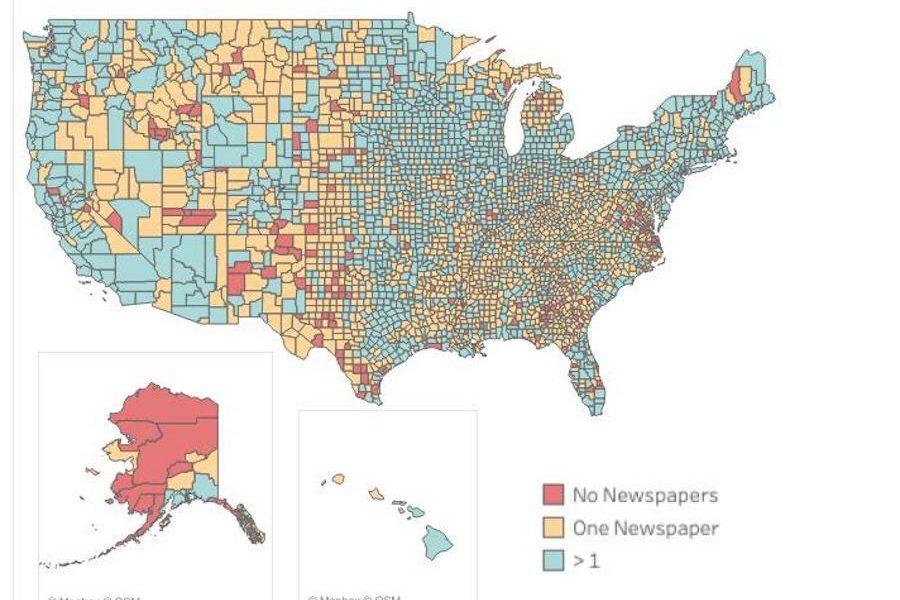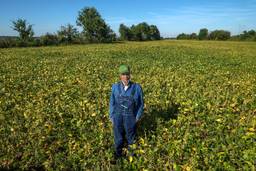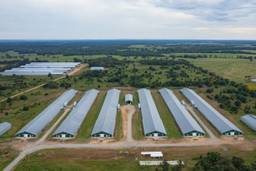
Editor’s Note: This article was originally published by Stateline, an initiative of the Pew Charitable Trusts.
Journalism professor Penny Muse Abernathy lives in a news desert. She says there’s little local media coverage of Scotland County, North Carolina, among the poorest in the Tar Heel state. Her television news broadcasts come from neighboring South Carolina.
As a result, it’s difficult to find local news or information on relevant state issues that she could vote on, Abernathy said.
A vibrant free press, protected from government interference by the First Amendment, can hold the powerful to account and empower readers to make informed decisions on major issues. Newspapers and other local media outlets reflect community values, and when they go under, there is less coverage of the high school sports and community events that bind people together.
Amid the steady decline in local news, some states are considering stepping in to support the Fourth Estate. But critics worry that doing so might undermine the press’s role as a government watchdog.
“There’s this adversarial relationship that exists and needs to exist,” said Al Cross, director of the Institute for Rural Journalism and Community Issues at the University of Kentucky in Lexington.
News deserts — communities with limited access to credible and comprehensive news — are especially prevalent in rural America. More than 500 of the 1,800 newspapers that have closed or merged since 2004 were in rural communities, according to a 2018 report, “The Expanding News Desert,” written by Abernathy for the University of North Carolina at Chapel Hill’s Center for Innovation and Sustainability in Local Media.
Rural newspapers have been buffeted by the same headwinds facing newspapers in all areas. More Americans are consuming news digitally, typically turning to news aggregation sites and social media for information, instead of getting it from local media outlets.
Revenue from classified and other print ads has declined precipitously as advertisers have moved online to accommodate those changing habits.
But the people with the least access to local news are rural residents, who are typically poorer and less educated than the average American.
As rural counties lose population, they often become unable to support a newspaper worthy of the name, Cross said. There just isn’t enough digital or print revenue in some rural communities to pay for public service journalism, according to the 2018 UNC report.
At the same time, many larger newspapers are closing their suburban and rural bureaus to save money.
In a report released earlier this year, the Pew Research Center found that about half of U.S. adults (47%) say the local news they get mostly covers an area other than where they live. (The Pew Charitable Trusts funds the research center and Stateline.)
Without reliable information on their own communities, there’s a potential for corruption, Abernathy said. People won’t be armed with the information they need to hold their public officials accountable and to make educated decisions when they vote.
She cited the recent case of a North Carolina campaign consultant who ran a network that illegally collected absentee ballots, and sometimes completed them, to boost a Republican congressional candidate.
Election officials eventually detected the fraud, overturned the election results, and ordered a new vote. But in the meantime, thousands of North Carolina voters, including those in Scotland County, were without representation.
“The residents of the 9th District have been deprived of a representative in Congress for almost a year,” Abernathy said, “because of significant election fraud that flew under the radar of severely understaffed local and regional newspapers, as well the state’s broadcast and digital outlets.”
On a recent Friday, the front pages of newspapers in two mostly rural states featured stories unlikely to merit a mention in national papers such as The New York Times and the Washington Post: The Anchorage Daily News led with a piece on a man accused of killing two Alaska Native women and dumping their bodies to cover his crimes, while the Arkansas Democrat-Gazette informed its readers of an agreement to phase out live greyhound racing at the West Memphis track where they have been held for 63 years.
Some believe state and local officials must act to preserve the flow of that information.
“A lot of people think about media and public policy and they get squeamish — ‘This is a hands-off thing. We can’t do anything about it,’” said Melissa Milios Davis, vice president of communications at the Denver-based Gates Family Foundation. “But in reality, this is an industry, just like any other. It’s a business, and the model is in crisis.”
The foundation supported research published earlier this month on public policies for supporting local news in Colorado, which lost 33 newspapers, about a fifth of the total, between 2004 and 2019.
In Massachusetts, state Rep. Lori Ehrlich and Sen. Brendan Crighton, both Democrats, have introduced a bill that would establish a commission to study journalism in underserved communities and make public policy recommendations.
Similar conversations are happening among advocates and legislators across the country, including in New Jersey, New York and Ohio.
Potential solutions include more money for public broadcasting, providing tax incentives to persuade media outlets to close local news gaps and following the path of New Jersey, which in 2018 created a fund to bring news and information to underserved communities.
There also is interest at the federal level. California U.S. Rep. Mark DeSaulnier, a Democrat, has proposed amending the federal tax code to make it easier for news organizations to claim nonprofit status. And Democratic Rep. David Cicilline of Rhode Island wants to allow news organizations to collectively negotiate with news aggregators such as Google and Facebook on the distribution of their content.
States Look to New Jersey
In 2017, the state of New Jersey had a windfall. It won $332 million in the Federal Communications Commission spectrum auction for selling off two public television stations in the Philadelphia and New York markets. It was the largest payout to any public broadcaster in the auction.
Free Press, a left-leaning organization that advocates for press freedom and local journalism, held a listening tour throughout the state to collect ideas on how the spectrum proceeds could be used to meet residents’ news and information needs.
Free Press’ work led to the New Jersey Civic Information Consortium, the result of a bipartisan bill that created an independent 501©3 public charity.
A collaboration among five of the state’s leading public higher-education institutions, the nonprofit’s mission is to strengthen local news coverage and boost civic engagement. It will award grants to projects that train students and others in journalism, storytelling and media production, and help media outlets find steady sources of revenue, among other goals.
But despite the spectrum windfall, and an initial request by Free Press and Senate and Assembly Democrats of $100 million, Democratic Gov. Phil Murphy has allocated just $2 million for the consortium.
Meanwhile critics worry that state-funded reporting is bound to worsen the crisis in local journalism, rather than ameliorate it.
“The fact that the consortium’s ruling body is top-heavy with government leaders and employees should give us pause,” media writer Jack Shafer wrote in Politico. “How can a nonprofit news organization directed by people in the government even pretend to be independent?”
Nevertheless, the Colorado Media Project earlier this month pointed to New Jersey as a model in a report that proposes four strategies to close local news gaps: increasing government transparency, increasing support for libraries and higher education, empowering communities to raise taxes to pay for local news, and helping commercial media outlets convert to a nonprofit model.
The report includes innovative, worthy ideas, such as increasing support to public broadcasting, but it also goes too far, said University of Kentucky’s Cross.
“It’s highly unlikely that the public policymakers in Colorado or any other states are going to adopt these types of recommendations because they’re too far-reaching for a lot of policymakers to swallow,” said Cross, who oversees the Rural Blog, an aggregator of rural news.
Still, advocates argue there is no future in local news without some form of public funding. Besides, public funding models have existed since President Lyndon B. Johnson signed the Public Broadcasting Act of 1967 and set up the Corporation for Public Broadcasting, a public-private corporation, to fill the gaps left by commercial media.
Some point to philanthropy as a possible solution, and nonprofit news websites supported by foundations and individual contributors have sprung up around the country. But few of them focus on rural issues, and even if they did, rural residents often lack high-speed internet access.
“There’s not going to be one fix,” Abernathy said. “The problem that we’ve got — and this is what I worry about the most — is the transition. How do we get through the next 10 years?”
Rural Public Media
Some advocates say public broadcasting can help fill the gaps. Collaborations among stations, such as in Kentucky, Ohio and West Virginia, report on economic and social change in Appalachia.
Public broadcasters are working alongside nearly three dozen digital and print newsrooms in Colorado, Idaho, Montana, New Mexico and Wyoming to expand coverage of the Mountain West.
While the print media industry is shrinking, some public broadcasters are growing. Colorado Public Radio, for example, is building a 9,000-square-foot news headquarters in downtown Denver and plans to add an investigative team. In the absence of state money, it has relied on generous major gifts and successful fundraising campaigns.
But some state legislators are moving in the opposite direction. Alaska this year eliminated state funding of public broadcasting, and stations are scrambling to make up for the shortfall. Fifteen states, including Colorado, don’t set aside money for public media. The loss of state money threatens the Alaska broadcasters’ ability to qualify for federal matching funds.
Alaska Gov. Michael Dunleavy, a Republican, used a line-item veto to eliminate more than $2.7 million in funding for the state’s public stations, which typically cover large geographic areas with small rural populations. They have weathered cuts before, but never faced a total loss.
“The more of us that lose staff, or that might end up going off the air, the weaker it makes the public media system as a whole,” said Jenny Neyman, general manager of KDLL in the Central Kenai Peninsula. The station airs local news, music programming and entertainment. It lost $74,000 — a third of its budget — in state funding.
“I grew up in one of those small bush communities where public radio is the only radio for a community like that,” Neyman said. “It would be quite a blow to not have that service anymore.”
Jeff Turner, a spokesman for the governor, did not return a request for comment.






